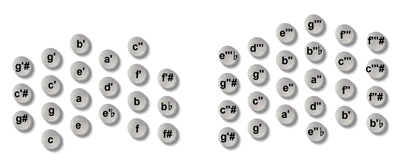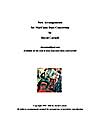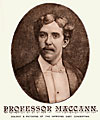Maccann Duet Concertina
Directory
Maccann Duet concertinas are designed to play a melody along with accompaniment
or to play multiple parts at the same time—so a single concertina can “play a duet with itself”.
Maccann Duet concertinas combine many of the
advantages from both of two earlier types (called “English concertinas” and
“Anglo concertinas”) and can be played in the style of either of those as well as
in many additional musical styles, either by ear or from music notation.
Concertinas are small and light (but loud) bellows-powered free-reed acoustic musical instruments
invented by the English physicist Sir Charles Wheatstone about 1830 as a high-tech
innovation in musical-instrument design. Unlike accordions (invented about the
same time), on a concertina each button plays one note at a time—no chord buttons. Despite the fact that
the earliest “English” concertinas were intended to play only a single musical part,
much like a violin, they were very popular in parlour ensembles and became something
of a fashionable craze in the mid-1850s.
Wheatstone and others worked on and patented a number of ways to extend
his design so as to make a Duet instrument, but none was widely used.
The first successful design for a Duet concertina was
patented in 1884 by a young performer,
“Professor” John Hill Maccann.
Maccann based his design on an earlier Wheatstone & Co. model,
but licensed his patent to Wheatstone's competitor Lachenal & Co.,
and wrote both a tutor for his new instrument and a more-general “Concertinist's Guide”
to promote it (his patent and both of his publications are available in full on this site).
Fine-quality Maccann-system instruments were also made by Wheatstone & Co.
after Maccann's patent expired in 1898, but Wheatstone never used Maccann's
name to describe them.
Maccann had great success performing with his new concertina, including a command performance
before HRH the Prince of Wales and a North American tour in 1890–1891, and his
“Improved Duet Concertina” became the instrument widely used by
professional performers in the late-Victorian music halls.
Its popularity continued until 1939 but did not survive the interruption
in production caused by World War II, and the art of
playing the Maccann Duet had become almost lost by mid-century. During its production,
a total of a few thousand instruments were manufactured.
Today there are perhaps fifty people world-wide who play antique Maccann Duet concertinas.
Maccann Duet concertinas remain admirable and ingenious personal music-makers; they can be played
in many musical styles, from simple to complex, and are excellent to accompany singing.
The chief barrier to their wider popularity is
that there are no new instruments, and refurbished antique instruments are now
both scarce and expensive.
Robert Gaskins
Instruction
-
 How to Play Chords on Any Maccann Duet Concertina
How to Play Chords on Any Maccann Duet Concertina
-
by Robert Gaskins
-
Explains how to play chords to accompany songs on Maccann Duet
concertinas of any size and from any period. Intended for beginners,
assumes no knowledge of musical notation or theory.
Includes a chord chart suitable for the lid of a concertina case. 51 pages.
-
Posted 15 February 2001
-
» read full article in pdf
-
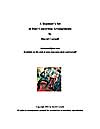 A Beginner's Set of Duet Concertina Arrangements
A Beginner's Set of Duet Concertina Arrangements
- by David Cornell
-
Six arrangements all in the key of C and progressing from easy to more
difficult, with detailed comments on fingering and technique and a
diagram of left hand bass pattersns. Includes: On Top of Old Smokey (two versions), Oh Susanna,
The Battle Hymn of the Republic, Sweet Sixteen, and Scotland the Brave.
18 pages.
- Posted 27 December 2001
-
» read full arrangements in pdf
-
 New Method of Instructions for the New Chromatic Duet English Concertina ... &c.
New Method of Instructions for the New Chromatic Duet English Concertina ... &c.
-
by John Hill Maccann
-
Maccann’s own tutor, first
published 1885 by Lachenal. Cover reads in part: "New Method
of Instructions for the New Chromatic Duet English Concertina,
with separate diagrams of keyboards and full instructions of
proper fingering, so arranged that without a knowledge of music
the instrument can be easily mastered ... Suitable for the 39,
47, or 56 Keyed Instrument. By J. H. Maccann, (Professor of the
Duet English Concertina)." First edition, London: Lachenal & Co., 1885. 43 pages.
Trim size 10 inches by 13 inches.
Updated 01 July 2003: Fourth edition (date unknown),
the cover of which reads in part "Suitable for the 39,
46 or 55 Keyed Instrument." 4th Edition. 43 pages.
This copy was provided by Bradley Strauchen, Deputy Keeper of Musical Instruments
at the Horniman Museum.
-
Posted 15 February 2003; last updated 01 July 2003
-
» (1st ed.) read full document in pdf
-
» (4th ed.) read full document in pdf
-
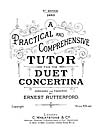 A Practical and Comprehensive Tutor for the Duet Concertina
A Practical and Comprehensive Tutor for the Duet Concertina
-
by Ernest Rutterford
-
The tutor for the Maccann Duet concertina which was published and sold
by Wheatstone over a very long period. It does not contain the name "Maccann,"
but refers only to the Wheatstone Duet.
(Wheatstone's Instructions for the Duet Concertina.) 4th ed.
London: undated (1930's?). From an original owned by Chris Algar. 56 pages.
-
Posted 15 November 2001
-
» read full article in pdf
-
 Maccann Duet Chords Tutor Manuscript
Maccann Duet Chords Tutor Manuscript
-
from Robert Gaskins
-
A polished 76-page manuscript “chords tutor” found in the
case of a matching 57-key Maccann Duet made by C. Jeffries Maker, 23 Praed St.
The instrument and the tutor are dated c. 1915. This may have been a “semi-bespoke”
tutor included with the instrument when it was originally sold.
Unlike the much later Jeffries System manuscript tutor (c. 1960) written with a biro
(ballpoint pen) in very rough style, this much-longer document was written with a split pen and
is very carefully finished.
-
Posted 15 February 2003
-
» read full document in pdf
-
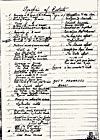 Stanley Manuscript Maccann Duet Tutor
Stanley Manuscript Maccann Duet Tutor
-
by Henry Stanley
-
One of a number of similar manuscript tutors for the Maccann Duet
Concertina written by Henry Stanley for his private pupils. Exercises,
scales, chords, tunes of graduated difficulty, tips on technique.
Hand written on music paper, 41 pages. This copy
belongs to Richard Evans.
-
Posted 15 May 2003
-
» read full document in pdf
-
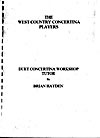 All-Systems Duet Workshop Tutor
All-Systems Duet Workshop Tutor
-
by Brian Hayden
-
Tutor for a workshop on how to play duet concertinas of all systems. Begins
with notation, fingering, and chords for Maccann Duets, Jeffries Duets, Crane (Triumph)
Duets, and Hayden Duets. Tunes of progressive difficulty, with increasing
number of notes and then in keys with increasing numbers of accidentals, all
written in notation based on the treble clef. Notes
on chord patterns and on strategies for melody and accompaniment applicable to
all systems of duet concertina.
Presented to The West Country Concertina Players, 1994. 20 pages.
-
Posted 15 August 2003
-
» read full document in pdf
-
 Garland Films Presents: “Reuben Shaw—Duet Concertina Player”
Garland Films Presents: “Reuben Shaw—Duet Concertina Player”
- by Barry Callaghan
-
On 7 February 1987, Barry Callaghan of Garland Films with fieldworker Graham Coyne
filmed a lengthy interview and demonstration, in which Reuben Shaw talks about his life and music.
He discusses early performers, his difficulties in finding music to study, and plays
the Maccann Duet concertina
from some of his collection of Henry Stanley manuscript arrangements.
This film has been available from Garland Films on PAL VHS tapes for some time, but now the entire film
is available on this website and is available on DVD from Garland Films.
STATUS: Article is online now with still pictures, but
video clips are not yet available for streaming (in production now).
- Posted Coming soon
- » read full article
-
 Which Duet Concertina—Hayden or Maccann?
Which Duet Concertina—Hayden or Maccann?
-
by Robert Gaskins
-
A comparative review of two concertinas:
a Stagi Hayden Duet concertina (c. 2003),
and a Lachenal Maccann Duet concertina (c. 1900).
Each instrument has 46 keys, and each cost
£500 ($800) ready to play.
On almost every measure, the antique Lachenal Maccann Duet
turned out to be preferable to the modern Stagi Hayden Duet—by
a considerable margin. The advantages frequently mentioned as
belonging to the Hayden system (uniformity of fingering in all
key signatures, automatic transposition) turned out to be significantly
compromised by the restricted size of the Stagi. If you want to
play a duet concertina, at present you will probably do best to
buy a Maccann Duet.
-
Posted 01 March 2004
-
» read full article
Music
-
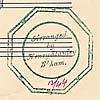 Arrangements of Music for Maccann Duet Concertina
Arrangements of Music for Maccann Duet Concertina
-
by Henry Stanley
-
Arrangements of music by Henry Stanley of Birmingham, a leading teacher and performer on
the Maccann Duet concertina from the period between world wars, and an early member of
the International Concertina Association. Stanley used his beautiful musical calligraphy
to write personal arrangements and tutors for his many pupils.
Most items from the Cecil C. White Archive of Henry Stanley Arrangements for Maccann Duet Concertina,
augmented by contributions from Richard Evans and others.
-
Posted 22 January 2005
-
» read full article
History
-
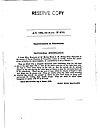 Improvements in Concertinas (1884)
Improvements in Concertinas (1884)
-
by John Hill Maccann
-
British Patent No. 4752 of 1884, Provisional Specification (12 March 1884)
and Complete Specification (18 November 1884) with two figures. 4 pages.
The one and only patent dealing with the Maccann Duet concertina.
Maccann's invention creates a fully chromatic Duet (capable of playing
in all key signatures) based on the older diatonic Wheatstone “duett” system.
-
Posted 15 November 2001
-
» read full document in pdf
-
 The Concertinist's Guide
The Concertinist's Guide
-
by John Hill Maccann
-
The Most Simple Modern Methods; How to Play
Correctly, With or Without a Tutor
8vo. London: Howard & Co., 1888.
Images from a microfilm of a copy at the Bodleian Library, replacing
a British Library copy destroyed in World War II. (Former British Library
shelfmark D-7808.c.14.(14.), replaced by British Library microfilm
Mic.A. 10532(4), Bodleian Shelfmark 17426 e 3(2).) Also a full
transcription which is searchable in the Adobe PDF reader. 50 pages.
-
Posted 15 November 2001
-
» read full document in pdf
-
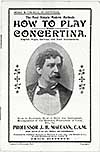 How to Play the Concertina
How to Play the Concertina
- by John Hill Maccann
-
A newly-discovered booklet, reliably dated to 1902.
The text of the document consists of two parts: (1) a
part of the "how to play" text from Maccann's earlier
publication The Concertinist's Guide (1888); and (2) an
interview with Professor Maccann reprinted from The Era
theatrical newspaper of London, issue of 25 January 1902.
In addition to the text,
the booklet contains some new photographs of Maccann,
including the first known photographs of him playing the concertina.
There is a sample program of a recital by Maccann, a list of phonograph
records for sale recorded by Maccann, and a catalogue of
some of Maccann's published music compositions.
This copy was discovered in the National Archives of
Australia, where it had been deposited for copyright registration.
- Posted 27 September 2004
-
» read article and full document
-
» read full document in pdf (medium quality)
-
» read full document in pdf (higher quality)
-
 Wheatstone Duet Concertina Pricelists
Wheatstone Duet Concertina Pricelists
- collected by Chris Algar
-
Most of these pricelists were found in old concertina cases. From internal evidence it is
possible to date the lists c. 1910 to c. 1965 (plus one very early pricelist for Double duets c. 1850).
These lists contain information about Wheatstone
model numbers and descriptions which are useful to interpret the Wheatstone Concertina Ledgers.
See also English pricelists from Wheatstone.
See also Anglo pricelists from Wheatstone.
- Posted 15 February 2003
- » go to directory
-
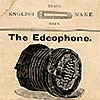 Lachenal Concertina Pricelists
Lachenal Concertina Pricelists
- collected by Chris Algar
-
Most of the earlier "pricelists" here were printed as trade advertisements, in dated serials.
Those actually issued as separate pricelists were found in old concertina cases; from internal evidence it is
possible to date these c. 1890 to c. 1925.
- Posted 07 March 2005
- » go to directory
-
 Wheatstone Concertina Ledgers on the Web
Wheatstone Concertina Ledgers on the Web
-
by the Horniman Museum
-
Historical business records from C. Wheatstone & Co. are held at the
Library of the Horniman Museum in London. The earliest ledgers from the Wayne Archives
contain company sales records from the late 1830s to the 1860s (though with some
large gaps) along with production records from the 1860s to the 1890s and some
early records of wages and other payments. Later ledgers from the Dickinson Archives
contain production records from 1910 to 1974, again with some gaps. All known ledgers
have been digitized (some 2,300 pages in total) and made available free on this website for
private research.
-
-
Posted 15 April 2003; Updated 15 June 2005
-
» go to website
-
 Prof. Maccann’s North American Tour (1890–1891)
Prof. Maccann’s North American Tour (1890–1891)
-
by Robert Gaskins
-
Newspaper theatrical notices from the Brooklyn (New York) Daily Eagle describe John Hill Maccann’s
appearances at Hyde and Behman’s Variety Theater, Brooklyn, in November 1890 and February 1891.
Updated 22 December 2003: added a notice from the New York Times for 27 January 1891, during
the same North American tour.
-
Posted 01 June 2003
-
» read full article
-
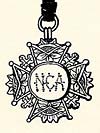 Professor Maccann: “America’s Champion Concertinist”
Professor Maccann: “America’s Champion Concertinist”
-
by Robert Gaskins
-
“PROFESSOR MACCANN, the celebrated concertinist, has
brought back with him from America a fine medal, which
became his property by a rival musician, Amducas Vestman,
failing to meet the Professor in a concertina contest
for the championship and $300. ...”
From The Era newspaper, London, 2 May 1891.
-
Posted 01 June 2003
-
» read full article
-
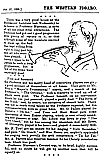 Professor Maccann Performs in Plymouth
Professor Maccann Performs in Plymouth
-
by Robert Gaskins
-
Extended review of a concert presented by Professor Maccann at
the Plymouth Mechanics’ Institute “on an instrument which
he has just patented,” from the Western Figaro newspaper,
Plymouth, 27 February 1885.
-
Posted 01 July 2003
-
» read full article
Technology
-
 Baffles for Maccann Duet Concertinas
Baffles for Maccann Duet Concertinas
- by Robert Gaskins
-
Explains how baffles fitted internally can reduce the volume
and/or change the tone of a Maccann Duet concertina,
and how the sound of each end can be controlled independently
so that the "balance" of an instrument can be altered.
The motivation for adding baffles is most often
to accompany a singer, to alter the sound-quality,
or to allow a right-hand melody to be heard while playing left-hand chords.
With 88 step-by-step photographs,
and web sources (UK and US) for all materials and tools needed.
15 March 2002: Updated with photos of early Wheatstone wooden baffles (from Paul Hardy)
and of Lachenal linen linings cut out individually around every button (from Joe Palof).
Also added, a photo of a unique ten-sided Maccann Duet which, rather than quieting
the left end with baffles, instead makes the right end louder by doubling all
the reeds on the right side (now owned by Neil Wayne, photo from Stephen Chambers).
15 February 2003: Updated with photos and description of very early Pre-Maccann
Wheatstone Double Duet No. 23 (1847-1848) which was equipped at the factory with conventional
baffles on both sides plus a special baffle inside the reed pan on the left side--only--to
balance the volume of the two ends.
- Posted 15 February 2002; last updated 15 February 2003
- » read full article
- » read section 1: "baffles for maccann duet concertinas"
- » read section 2: "step-by-step photographs"
- » read section 3: "appendices, where to buy materials"
-
 A Chat with Brian Hayden
A Chat with Brian Hayden
- by Wes Williams
-
Brian Hayden was interviewed in 2001 about his background, his invention of
the Hayden System, his views on other duet systems, and his suggestions
for learning and playing the duet concertina. Contains keyboard diagrams
for nine duet systems: the Early Wheatstone Duett, Early Wheatstone Double, Maccann,
Jeffries, Crane (Triumph), Linton, Rust ("Piano"), Late Wheatstone Chidley, and Hayden.
(There is also
a PDF version of the article.)
Also published at concertina.net.
- Posted 15 February 2003
- » read full article
- » read full article in pdf
-
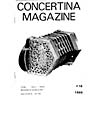 Fingering Systems for Duet Concertina
Fingering Systems for Duet Concertina
-
by Brian Hayden
-
Overview of all the fingering systems for duet concertina which
turned up in Hayden's review of prior art while preparing his own patent application.
As published in Concertina Magazine (Australia)
16 (1986): 19-23; 17 (1987): 7-9; 18 (1987): 11-15; 19 (1987): 6-10.
-
Posted 15 November 2001
-
» read full article in pdf
-
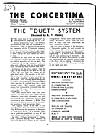 The 'Duet' System, discussed by K. V. Chidley
The 'Duet' System, discussed by K. V. Chidley
-
by Kenneth V. Chidley
-
Review of the history of the duet concertina leading up to
Chidley's own post-war "Chidley System".
As published in World Accordion Review
6:3 (December 1950): 31-32. Also a differing version
as reprinted with notes by Neil Wayne
as K. V. Chidley, "The Duet Concertina--Its History and the Evolution
of its Keyboard," Free Reed: The Concertina Newsletter 17
(Jan/Feb 1974): 15-17.
-
Posted 15 November 2001
-
» read full article in pdf
-
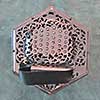 Photographs of Jeffries Maccann Duet Concertina, serial No. 6
Photographs of Jeffries Maccann Duet Concertina, serial No. 6
- by Robert Gaskins
-
Photographic documentation of a Jeffries Maccann Duet, serial No. 6, 57 keys, c. 1915.
Marked on the right with an oval engraved C. Jeffries Maker, 23 Praed St. Raised
metal ends, some construction details in common with Jeffries anglos such as linear
reed chambers. Its matching manuscript chords tutor is also reproduced on this website.
54 photographs.
- Posted 15 February 2003
- » read full article
Research
-
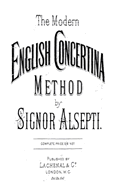 Instruction Manuals for the English, Anglo, and Duet Concertina: An Annotated Bibliography
Instruction Manuals for the English, Anglo, and Duet Concertina: An Annotated Bibliography
- by Randall C. Merris
-
A comprehensive bibliography with more than 200 citations for
concertina tutors that were published from the 1840s to the present.
Separate sections deal with English, Anglo, and Duet tutors.
The annotations contain
considerable historical material on concertina makers, authors and teachers, performers,
and publishers in the UK, US, and elsewhere. The web version incorporates citations for tutors
that have appeared or were located subsequent to the original publication (about 35 more by 2005)
and adds over 100 scanned photographs of tutor covers.
A number of the tutors are available scanned
in full on this website, and these are indicated in the entries.
The original publication was in The Free-Reed Journal 4 (2002): 85-118,
and a PDF version of the printed article is also available online.
- Posted 01 April 2003; last updated 31 August 2005
- » read full article
- » read Part 1, "English Concertina"
- » read part 2, "Anglo Concertina"
- » read part 3, "Duet Concertina"
- » read original article (without updates) in pdf"
-
 A Wheatstone Twelve-Sided 'Edeophone' Concertina with Pre-Maccann Chromatic Duet Fingering
A Wheatstone Twelve-Sided 'Edeophone' Concertina with Pre-Maccann Chromatic Duet Fingering
-
by Neil Wayne, Margaret Birley, and Robert Gaskins
-
A duet concertina (serial no. 35074) with a unique fingering arrangement, made by Wheatstone
in 1938, turns out to be a realization of a design from Wm. Wheatstone's patent of 1861.
The instrument is twelve-sided, a Registered Design feature of Lachenal & Co., and it
turns out to be one of at least sixteen twelve-sided instruments made by Wheatstone between
1934 and 1941. The instrument is now in the collection of the Horniman Museum, London.
As published in The Free-Reed Journal 3 (2001): 3-17.
This HTML version of the article adds a number of additional photographs and
active links to many of the sources cited in the published article.
Updated 15 August 2003: Footnote 11 updated to record that Randall C. Merris has
located instrument serial #33301, another of the set of three twelve-sided 40-key Anglos.
-
Posted 15 November 2001; last updated 15 August 2003
-
»
read full article
-
»
read original article (without updates or additions) in pdf
-
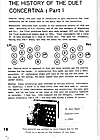 History of the Duet Concertina
History of the Duet Concertina
-
by Phil Inglis
-
When it was written, this was the only survey article on the subject, plus some anecdotes. The
last twenty years have produced some additional information.
As published in Concertina Magazine (Australia), 12 (Autumn, 1985): 18-19,
13 (Winter, 1985): 18-20, 14 (Spring 1985): 11-13.
-
Posted 15 February 2003
-
» read full article in pdf
-
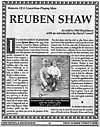 Memoirs of a Concertina-Playing Man: Reuben Shaw
Memoirs of a Concertina-Playing Man: Reuben Shaw
-
as told to Phil Hopkinson, with an introduction by David Cornell
-
Memoirs of a player, a teacher, a link with the great British concertina tradition, and
a fine story teller, who has played the Maccann Duet concertina for over fifty years.
Reprinted from Concertina & Squeezebox,
issue 29 (1993), pp. 12-17. Posted to honor Reuben Shaw’s 90th birthday, and to commemorate his
appearance at the English Country Music Weekend at High Bradfield, Nr Sheffield, UK, 20-22 June 2003.
-
Posted 15 June 2003
-
» read full article in pdf
Do you know another resource that we should include?
Tell us about it.
Reprinted from the Concertina Library
http://www.concertina.com
© Copyright 2000– by Robert Gaskins
|
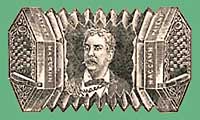
U.K. trade mark No. 164,303,
published 21 April 1892,
concertina with portrait
and signature of J. H. Maccann
|


